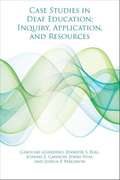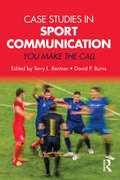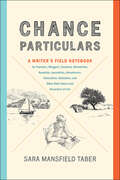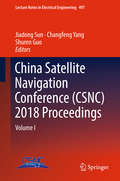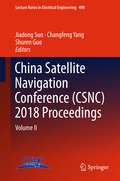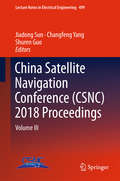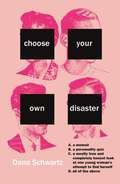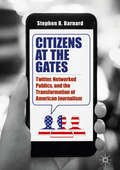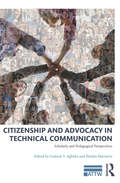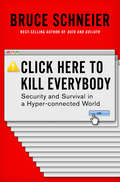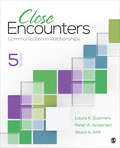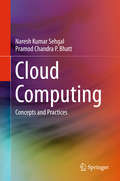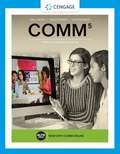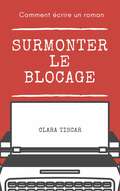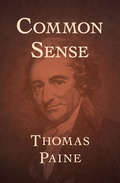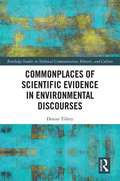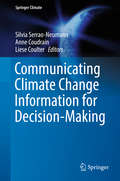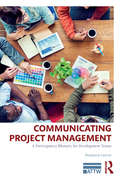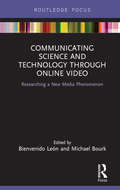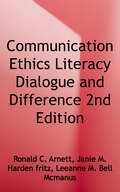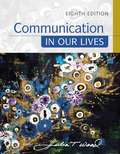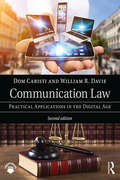- Table View
- List View
Case Studies in Deaf Education: Inquiry, Application, and Resources
by Caroline Guardino Jennifer S. Beal Joanna E. Cannon Jenna Voss Jessica P. BergeronCase Studies in Deaf Education provides comprehensive materials that will prepare prospective teachers to work with the diverse spectrum of students who are d/Deaf and hard of hearing (d/Dhh) and empower them to better understand these complex and unique learners. The text presents an extensive series of case studies that are balanced and unbiased in both language and instructional approaches and that encourage readers to use background details, academic data, and evidence-based practices to make informed educational decisions. The authors address the diversity of d/Dhh students by examining a multitude of learner characteristics that influence communication and educational services. These characteristics and their interactions include a student’s background experiences, language and communication mode (sign and/or listening and spoken language), language and academic proficiency levels, use of assistive hearing devices (hearing aids or cochlear implants), and family dynamics. The case studies are supported with authentic supplemental materials, such as audiograms and Individualized Educational Plans, and are accompanied by discussion questions, activities, resource lists, and a glossary of essential terms. Case Studies in Deaf Education will help teachers and allied professionals develop the knowledge and skills to use a collaborative, problem-solving process that leads to the provision of quality, effective services for students who are d/Dhh. An electronic instructor’s manual accompanies this text and will be available upon publication.
Case Studies in Sport Communication: You Make the Call
by Terry L. Rentner David P. BurnsCase Studies in Sport Communication: You Make the Call goes beyond the box scores by offering readers the opportunity to evaluate popular and diverse issues in sport—including management, crisis, health, ethics, gender, race, and social media. Each chapter incorporates theory and communication principles as well as topical background information, and concludes with discussion questions and engaging assignments. This volume presents real-life, provocative sports cases that bring contemporary headlines into perspective and inspire critical thinking. Each chapter features scholarly evidence that will keep the conversation lively, thoughtful, and informative. Students are encouraged to challenge the ethical implications of what they have read and to “make the call.” This is an invaluable resource for upper-level undergraduate and graduate students of sport communication and sport management.
Chance Particulars: A Writer's Field Notebook for Travelers, Bloggers, Essayists, Memoirists, Novelists, Journalists, Adventurers, Naturalists, Sketchers, and Other Note-Takers and Recorders of Life
by Sara Mansfield Taber“A guide to paying attention to the concrete, sensory details of experience and the process of getting them down on the page.” —James Barilla, author of My Backyard JungleBased on what accomplished nonfiction writer Sara Mansfield Taber learned in her many years of field notebook keeping, Chance Particulars is a unique and handy primer for writers who want to use their experiences to tell a lively, satisfying story. Often, writers try to turn their notes into a memoir, essay, travel piece, or story, only to find that they haven’t recorded enough of details necessary to create evocative description. To help writers overcome this problem, Taber has composed a true “field notebook for field notebook keepers.” Enhanced by beautiful illustrations, this charming and comprehensive guide is a practical manual for anyone who wishes to learn or hone the crafts of writing, ethnography, or journalism.Writers of all levels, genres, and ages, as well as teachers of writing, will appreciate this useful tool for learning how to record the details that build vibrant prose. With this book in hand, you will be able to recreate times and places, conjure up intricate character portraits, and paint pictures of particular landscapes, cultures, and locales.“At once a delicious read and the distilled wisdom of a long-time teacher and virtuoso of the literary memoir. Her powerful lessons will give you rare and vital skills: to be able to read the world around you, and to read other writers, as a writer, that is, with your beadiest conjurer’s eye and mammoth heart. This is a book to savor, to engage with, and to reread, again and again.” —C. M. Mayo, author of Miraculous Air
Chicago by the Book: 101 Publications That Shaped the City and Its Image
by Neil Harris Caxton ClubDespite its rough-and-tumble image, Chicago has long been identified as a city where books take center stage. In fact, a volume by A. J. Liebling gave the Second City its nickname. Upton Sinclair’s The Jungle arose from the midwestern capital’s most infamous industry. The great Chicago Fire led to the founding of the Chicago Public Library. The city has fostered writers such as Nelson Algren, Saul Bellow, and Gwendolyn Brooks. Chicago’s literary magazines The Little Review and Poetry introduced the world to Eliot, Hemingway, Joyce, and Pound. The city’s robust commercial printing industry supported a flourishing culture of the book. With this beautifully produced collection, Chicago’s rich literary tradition finally gets its due. Chicago by the Book profiles 101 landmark publications about Chicago from the past 170 years that have helped define the city and its image. Each title—carefully selected by the Caxton Club, a venerable Chicago bibliophilic organization—is the focus of an illustrated essay by a leading scholar, writer, or bibliophile. Arranged chronologically to show the history of both the city and its books, the essays can be read in order from Mrs. John H. Kinzie’s 1844 Narrative of the Massacre of Chicago to Sara Paretsky’s 2015 crime novel Brush Back. Or one can dip in and out, savoring reflections on the arts, sports, crime, race relations, urban planning, politics, and even Mrs. O’Leary’s legendary cow. The selections do not shy from the underside of the city, recognizing that its grit and graft have as much a place in the written imagination as soaring odes and boosterism. As Neil Harris observes in his introduction, “Even when Chicagoans celebrate their hearth and home, they do so while acknowledging deep-seated flaws.” At the same time, this collection heartily reminds us all of what makes Chicago, as Norman Mailer called it, the “great American city.” With essays from, among others, Ira Berkow, Thomas Dyja, Ann Durkin Keating, Alex Kotlowitz, Toni Preckwinkle, Frank Rich, Don Share, Carl Smith, Regina Taylor, Garry Wills, and William Julius Wilson; and featuring works by Saul Bellow, Gwendolyn Brooks, Sandra Cisneros, Clarence Darrow, Erik Larson, David Mamet, Studs Terkel, Ida B. Wells-Barnett, Frank Lloyd Wright, and many more.
China Satellite Navigation Conference: Volume I (Lecture Notes in Electrical Engineering #497)
by Jiadong Sun Changfeng Yang Shuren GuoThese proceedings present selected research papers from CSNC 2018, held during 23rd-25th May in Harbin, China. The theme of CSNC 2018 is Location, Time of Augmentation. These papers discuss the technologies and applications of the Global Navigation Satellite System (GNSS), and the latest progress made in the China BeiDou System (BDS) especially. They are divided into 12 topics to match the corresponding sessions in CSNC 2018, which broadly covered key topics in GNSS. Readers can learn about the BDS and keep abreast of the latest advances in GNSS techniques and applications.
China Satellite Navigation Conference: Volume II (Lecture Notes in Electrical Engineering #498)
by Jiadong Sun Changfeng Yang Shuren GuoThese proceedings present selected research papers from CSNC 2018, held during 23rd-25th May in Harbin, China. The theme of CSNC 2018 is Location, Time of Augmentation. These papers discuss the technologies and applications of the Global Navigation Satellite System (GNSS), and the latest progress made in the China BeiDou System (BDS) especially. They are divided into 12 topics to match the corresponding sessions in CSNC 2018, which broadly covered key topics in GNSS. Readers can learn about the BDS and keep abreast of the latest advances in GNSS techniques and applications.
China Satellite Navigation Conference: Volume III (Lecture Notes in Electrical Engineering #499)
by Jiadong Sun Changfeng Yang Shuren GuoThese proceedings present selected research papers from CSNC 2018, held during 23rd-25th May in Harbin, China. The theme of CSNC 2018 is Location, Time of Augmentation. These papers discuss the technologies and applications of the Global Navigation Satellite System (GNSS), and the latest progress made in the China BeiDou System (BDS) especially. They are divided into 12 topics to match the corresponding sessions in CSNC 2018, which broadly covered key topics in GNSS. Readers can learn about the BDS and keep abreast of the latest advances in GNSS techniques and applications.
Choose Your Own Disaster
by Dana SchwartzA hilarious, quirky, and unflinchingly honest memoir about one young woman's terrible and life-changing decisions while hoping (and sometimes failing) to find herself, in the style of Never Have I Ever and Adulting. Join Dana Schwartz on a journey revisiting all of the terrible decisions she made in her early twenties through the internet's favorite method of self-knowledge: the quiz. Part-memoir, part-VERY long personality test, CHOOSE YOUR OWN DISASTER is a manifesto about the millennial experience and modern feminism and how the easy advice of "you can be anything you want!" is actually pretty fucking difficult when there are so many possible versions of yourself it seems like you could be. Dana has no idea who she is, but at least she knows she's a Carrie, a Ravenclaw, a Raphael, a Belle, a former emo kid, a Twitter addict, and a millennial just trying her best.
Citizens at the Gates: Twitter, Networked Publics, and the Transformation of American Journalism
by Stephen R. BarnardDrawing insights from nearly a decade of mixed-method research, Stephen R. Barnard analyzes Twitter’s role in the transformation of American journalism. As the work of media professionals grows increasingly hybrid, Twitter has become an essential space where information is shared, reporting methods tested, and power contested. In addition to spelling opportunity for citizen media activism, the normalization of digital communication adds new channels of influence for traditional thought leaders, posing notable challenges for the future of journalism and democracy. In his analyses of Twitter practices around newsworthy events—including the Boston Marathon bombing, protests in Ferguson, Missouri, and the election of Donald Trump—Barnard brings together conceptual and theoretical lenses from multiple academic disciplines, bridging sociology, journalism, communication, media studies, science and technology studies, and political science.
Citizenship and Advocacy in Technical Communication: Scholarly and Pedagogical Perspectives (ATTW Series in Technical and Professional Communication)
by Godwin Y. Agboka Natalia MatveevaIn Citizenship and Advocacy in Technical Communication, teachers, researchers, and practitioners will find a variety of theoretical frameworks, empirical studies, and teaching approaches to advocacy and citizenship. Specifically, the collection is organized around three main themes or sections: considerations for understanding and defining advocacy and citizenship locally and globally, engaging with the local and global community, and introducing advocacy in a classroom. The collection covers an expansive breadth of issues and topics that speak to the complexities of undertaking advocacy work in TPC, including local grant writing activities, cosmopolitanism and global transnational rhetoric, digital citizenship and social media use, strategic and tactical communication, and diversity and social justice. The contributors themselves, representing fifteen academic institutions and occupying various academic ranks, offer nuanced definitions, frameworks, examples, and strategies for students, scholars, practitioners, and educators who want to or are already engaged in a variegated range of advocacy work. More so, they reinforce the inherent humanistic values of our field and discuss effective rhetorical and current technological tools at our disposal. Finally, they show us how, through pedagogical approaches and everyday mundane activities and practices, we (can) advocate either actively or passively.
Click Here to Kill Everybody: Security And Survival In A Hyper-connected World
by Bruce SchneierA world of "smart" devices means the Internet can kill people. We need to act. Now. Everything is a computer. Ovens are computers that make things hot; refrigerators are computers that keep things cold. These computers—from home thermostats to chemical plants—are all online. The Internet, once a virtual abstraction, can now sense and touch the physical world. As we open our lives to this future, often called the Internet of Things, we are beginning to see its enormous potential in ideas like driverless cars, smart cities, and personal agents equipped with their own behavioral algorithms. But every knife cuts two ways. All computers can be hacked. And Internet-connected computers are the most vulnerable. Forget data theft: cutting-edge digital attackers can now crash your car, your pacemaker, and the nation’s power grid. In Click Here to Kill Everybody, renowned expert and best-selling author Bruce Schneier examines the hidden risks of this new reality. After exploring the full implications of a world populated by hyperconnected devices, Schneier reveals the hidden web of technical, political, and market forces that underpin the pervasive insecurities of today. He then offers common-sense choices for companies, governments, and individuals that can allow us to enjoy the benefits of this omnipotent age without falling prey to its vulnerabilities. From principles for a more resilient Internet of Things, to a recipe for sane government regulation and oversight, to a better way to understand a truly new environment, Schneier’s vision is required reading for anyone invested in human flourishing.
Close Encounters: Communication in Relationships
by Dr Laura K. Guerrero Dr Peter A. Andersen Dr Walid AfifiA relational approach to the study of interpersonal communication Close Encounters: Communication in Relationships, Fifth Edition helps students better understand their relationships with romantic partners, friends, and family members. Bestselling authors Laura K. Guerrero, Peter A. Andersen, and Walid A. Afifi offer research-based insights and content illustrated with engaging scenarios to show how state-of-the-art research and theory can be applied to specific issues within relationships—with a focus on issues that are central to describing and understanding close relationships. While maintaining the spotlight on communication, the authors also emphasize the interdisciplinary nature of the study of personal relationships by including research from such disciplines as social psychology and family studies. The book covers issues relevant to developing, maintaining, repairing, and ending relationships. Both the "bright" and "dark" sides of interpersonal communication within relationships are explored.
Close Encounters: Communication in Relationships
by Dr Laura K. Guerrero Dr Peter A. Andersen Dr Walid AfifiA relational approach to the study of interpersonal communication Close Encounters: Communication in Relationships, Fifth Edition helps students better understand their relationships with romantic partners, friends, and family members. Bestselling authors Laura K. Guerrero, Peter A. Andersen, and Walid A. Afifi offer research-based insights and content illustrated with engaging scenarios to show how state-of-the-art research and theory can be applied to specific issues within relationships—with a focus on issues that are central to describing and understanding close relationships. While maintaining the spotlight on communication, the authors also emphasize the interdisciplinary nature of the study of personal relationships by including research from such disciplines as social psychology and family studies. The book covers issues relevant to developing, maintaining, repairing, and ending relationships. Both the "bright" and "dark" sides of interpersonal communication within relationships are explored.
Cloud Computing: Concepts And Practices
by Naresh Kumar Sehgal Pramod Chandra P. BhattThis book provides readers with an overview of Cloud Computing, starting with historical background on mainframe computers and early networking protocols, leading to current concerns such as hardware and systems security, performance, emerging areas of IoT, Edge Computing etc. Readers will benefit from the in-depth discussion of cloud computing usage and the underlying architecture, with focus on best practices for using a dynamic cloud infrastructure, cloud operations management and cloud security. The authors explain carefully the “why’s and how’s” of Cloud Computing, so engineers will find this book and invaluable introduction to the topic.
Comm 5
by Rudolph F. Verderber Kathleen S. Verderber Deanna D. SellnowLearn Communication YOUR Way with COMM5! This easy-reference, paperback textbook presents course content through visually engaging chapters and Chapter Review Cards that consolidate the best review material into a ready-made study tool. With the textbook or on its own, COMM5 Online allows easy exploration of COMM5 anywhere, anytime--including on your device. Collect your notes, browse interactive content and create StudyBits as you go, to remember what's important. Then, either use preset study resources or personalize the product through easy-to-use tags and filters to prioritize your study time. Make and review flashcards, review related content and track your progress with Concept Tracker--all in one place and at an affordable price!
Comment écrire un roman: Surmonter le blocage
by Sophie Martin Clara TiscarVous avez envie d’écrire ? Vous avez déjà eu l’impression d’être bloqué ? Vivez-vous l’angoisse de la page blanche ? Ce livre est fait pour vous si vous vous reconnaissez dans l’une des situations suivantes : ✓ J’ai envie d’écrire, mais je ne trouve pas le moment de le faire. ✓ Je suis bloqué, je ne sais pas comment continuer mon roman. ✓ Je sais quelle histoire je souhaite raconter, mais je n’arrive pas à l’écrire. ✓ Je ne suis pas vraiment bloqué, mais je manque de motivation pour continuer d’écrire mon roman. Conçu comme un guide de référence pratique et interactif, cet ouvrage vous offre méthodes et ressources pour surmonter l'angoisse de la page blanche et éviter le blocage de l'écrivain.
Common Sense
by Thomas PaineThe rousing argument for independence that inspired a nation Published anonymously in 1776, this landmark political pamphlet spread across the colonies more rapidly than any document of its kind ever had before. Its words were read aloud in town squares, its pages affixed to tavern walls. Both a clear-eyed, plainly stated case for separation from Great Britain and a stirring call to action, Common Sense sparked the imagination of a fledgling nation and played a decisive role in the march toward revolution. Thomas Paine’s masterpiece is crucial reading for any student of American history. This ebook has been professionally proofread to ensure accuracy and readability on all devices.
Commonplaces of Scientific Evidence in Environmental Discourses (Routledge Studies in Technical Communication, Rhetoric, and Culture)
by Denise TilleryThis book focuses on the uses of scientific evidence within three types of environmental discourses: popular nonfiction books about the environment; traditional and social media texts created by a grassroots environmental group; and a set of data displays that make arguments about global warming in a variety of media and contexts. It traces the operations of eight commonplaces about science and shows how they recur throughout these contexts, starting with Rachel Carson’s Silent Spring and ending with contemporary blogs and social media. The commonplaces are shown to embed ideological assumptions and simultaneously challenge those assumptions. In addition, the book addresses the potential dangers involved in relying too heavily on aspects of these commonplaces, and how they can undermine the goals of some of the writers who use them.
Communicating Climate Change Information for Decision-Making (Springer Climate)
by Silvia Serrao-Neumann Anne Coudrain Liese CoulterThis book provides important insight on a range of issues focused on three themes; what new climate change information is being developed, how that knowledge is communicated and how it can be usefully applied across international, regional and local scales. There is increasing international investment and interest to develop and communicate updated climate change information to promote effective action. As change accelerates and planetary boundaries are crossed this information becomes particularly relevant to guide decisions and support both proactive adaptation and mitigation strategies. Developing new information addresses innovations in producing interdisciplinary climate change knowledge and overcoming issues of data quality, access and availability. This book examines effective information systems to guide decision-making for immediate and future action. Cases studies in developed and developing countries illustrate how climate change information promotes immediate and future actions across a range of sectors.
Communicating Project Management: A Participatory Rhetoric for Development Teams (ATTW Series in Technical and Professional Communication)
by Benjamin LaurenCommunicating Project Management argues that the communication practices of project managers have necessarily become participatory, made up of complex strategies and processes solidly grounded in rhetorical concepts. The book draws on case studies across organizational contexts and combines individual experiences to investigate how project management relies on communication as teams develop products, services, and internal processes. The case studies also provide examples of how project managers can be understood and studied as writers, further arguing project managers must approach communication as designed experience that must be intentionally inclusive. Author Benjamin Lauren illustrates to readers how teams work together to manage projects through complex coordinative communication practices, and highlights how project managers are constantly learning and evolving by analyzing where they succeed and fail. He concludes that technical and professional communicators have a pivotal role in supporting and facilitating participative approaches to communicating project management.
Communicating Science and Technology Through Online Video: Researching a New Media Phenomenon (Routledge Focus on Communication Studies)
by Bienvenido León Michael BourkOnline video’s unique capacity to reach large audiences makes it a powerful tool to communicate science and technology to the general public. The outcome of the international research project "Videonline," this book provides a unique insight into the key elements of online science videos, such as narrative trends, production characteristics, and issues of scientific rigor. If offers various methodological approaches: a literature review, content analysis, and interviews and surveys of expert practitioners to provide information on how to maintain standards of rigour and technical quality in video production.
Communication Ethics Literacy: Dialogue and Difference
by Ronald C. Arnett Janie M. Harden Fritz Leeanne M. Bell McmanusCommunication ethics is imperative in the 21st century as the prevalence of conflicting opinions endangers successful, respectful communication. <p><p>Utilizing a dialogic approach to ethical communication, Communication Ethics Literacy: Dialogue and Difference provides a timely review of classic communication ethics literature and extends the conversation about dialogue and difference in public and private life. <p><p>Understanding communication ethics as a pragmatic survival skill in a world of difference, this work frames communication ethics as a discipline and practice that arises from multiple understandings of goods found across diverse narratives, traditions, and virtue structures that guide human life.
Communication In Our Lives
by Julia WoodCOMMUNICATION IN OUR LIVES, 8th Edition, provides everything you need to become a more confident and effective communicator -- in both your personal and professional life. Award-winning teacher Julia T. Wood combines the latest research, theory, and best practices with hands-on skills development. Extremely student friendly, the text features an engaging, personal tone, while frequent Student Voice sections highlight how past students have experienced key communication concepts. <p><p> In addition to its signature emphasis on social and cultural diversity, the eighth edition includes expanded coverage of digital media, a new focus on health communication, and an early introduction to public speaking -- with plenty of sample speeches. The text also illustrates the importance of effective communication to today's careers. Interactive, online study tools help you put what you learn into practice as you strengthen your interpersonal, group, public speaking, and media skills.
Communication Law: Practical Applications in the Digital Age
by William R Davie Dom CaristiNow in its second edition, Communication Law: Practical Applications in the Digital Age is an engaging and accessible text that brings a fresh approach to the fundamentals of mass media law. Designed for students of communication that are new to law, this volume presents its readers with key principles and emphasizes the impact of timely, landmark cases on today’s media world, providing an applied learning experience. This new edition offers a brand new chapter on digital media law, a wealth of new case studies, and expanded discussions of current political, social, and cultural issues.
Communication Matters (Third Edition)
by Kory FloydCommunication Matters: Effective communicators are made, not born. We all communicate, all the time. Consequently, many of us believe we're experts, that good communication is based on personal instincts. In this highly interactive program, students learn to think through how they communicate rather than rely solely on their instincts. They develop the skills needed to become effective communicators. Communication Matters prompts students to question their assumptions, challenges them to think critically about why and how they communicate in the ways that they do, and provides solid tools and takeaways that students can employ to communicate effectively even in difficult situations. Through an adaptive reading experience with SmartBook, student videos for public speaking, and dynamic online activities, Communication Matters urges students to consider which choices are likely to be effective and which less so.
